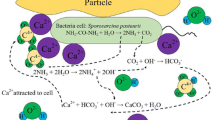Abstract
Microbes can produce CO 2−3 in an environment conductive to precipitation, so the incompact sands will be consolidated. This technology is environmentally friendly not only because it gives strength to the sand body, but also it allows water to penetrate into the sand body, which is unlike silicate cement that will destroy the ecosystem of the earth. After comparing the activity of three kinds of bacteria, the most suitable one was chosen for the study. However, the activity of this bacterium was still not high enough for the purpose, so it was purified. A suitable program for the consolidation and cementation of sands was also found in the experiment. The compressive strength and the porosity of the cemented sand body were tested to characterize the cementation effectiveness. XRD analysis showed that a new phase of calcite was produced between sand grains. The content of calcite was detected by TG. The study showed that the precipitation program was quite important to obtain a sound cemented sand body in addition to the activity of the bacteria.
Similar content being viewed by others
References
Cheng L, Qian C X. Advances in the research of mechanism of biomineralizing calcium carbonate (in Chinese). Bull Chinese Ceram Soc, 2006, 25(6): 108–116
Victoria S W, van Paassen L A, Marien P H. Microbial carbonate precipitation as a soil improvement technique. Geomicrobiol J, 2007, 24(5): 417–423
Nemati M, Greene E A, Voordouw G. Permeability profile modification using bacterially formed calcium carbonate: Comparison with enzymic option. Process Biochem, 2005, (40): 925–933
Cheng L, Qian C X, Wang R X, et al. Study on the mechanism of calcium carbonate formation induced by carbonate-mineralization microbe (in Chinese). Acta Chim Sin, 2007, 65(19): 2133–2138
Wang R X, Qian C X, Wu M, et al. Study on heavy metals in soil mineralized by bacteria (in Chinese). J Funct Mater, 2007, 9(38): 1523–1530
Ghosha P, Mandala S, Chattopadhyayb B D, et al. Use of microorganism to improve the strength of cement mortar. Cement Concrete Res, 2005, (35): 1980–1983
Sabine C, Gae’le le Me’tayer-Levrel, Jean-Pierre P. Ca-carbonates precipitation and limestone genesis—The microbiogeologist point of view. Sediment Geol, 1999, (126): 9–23
GB/T 50081-2002. Standard for Test Method of Mechanical Properties on Ordinary Concrete (in Chinese). Beijing: China Architecture & Building Press, 2003
Fu F, Zhang Y M, Sun D S. Civil Engineering Material (in Chinese). 3rd ed. Nanjing: Southeast University Press, 2006
de Muynck W, de Belie N, Verstraete W. Improvement of concrete durability with the aid of bacteria. In: Proc 1st Int Conf Self Healing Mater, Noordwijkaan Zee, The Netherlands, 2007. 18–20
Wang R X, Qian C X, Wang J Y. Study on microbiological precipitation of CaCO3 (in Chinese). J Southeast Univ, 2005, (35):192–195
Lin X L. Studies on behavior of pyrogenation of shell and effect on pyrogenation of polymer (in Chinese). Dessertation of Master Degree. Anhui: Anhui University of Science & Engineering, 2006
Tao J, Yao Z J, Xue F. Essentials of Materials Science and Engineering (in Chinese). Beijing: Chemical Industry Press, 2006
Liu J G, Jiang X M, Wang H, et al. Thermal behavior and surface microstructure of quartzite particles (in Chinese). J Chem Ind Eng, 2007, 58(3): 765–770
Jan D, de Windt W, de Graef B, et al. Bio-deposition of a calcium carbonate layer on degraded limestone by Bacillus species. Biodegradation, 2006, (17): 357–367
Author information
Authors and Affiliations
Corresponding author
Rights and permissions
About this article
Cite this article
Qian, C., Pan, Q. & Wang, R. Cementation of sand grains based on carbonate precipitation induced by microorganism. Sci. China Technol. Sci. 53, 2198–2206 (2010). https://doi.org/10.1007/s11431-009-3189-z
Received:
Accepted:
Published:
Issue Date:
DOI: https://doi.org/10.1007/s11431-009-3189-z




